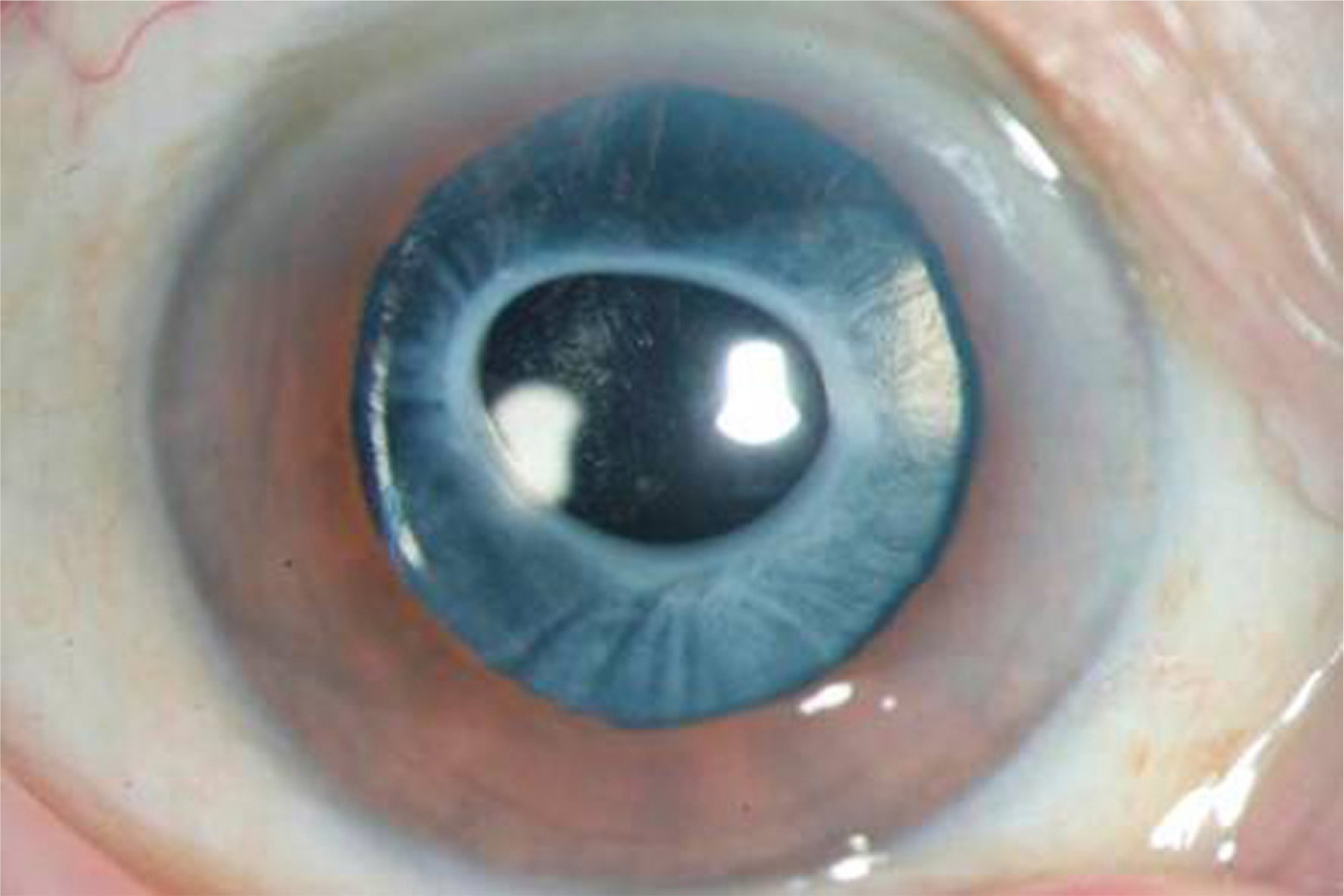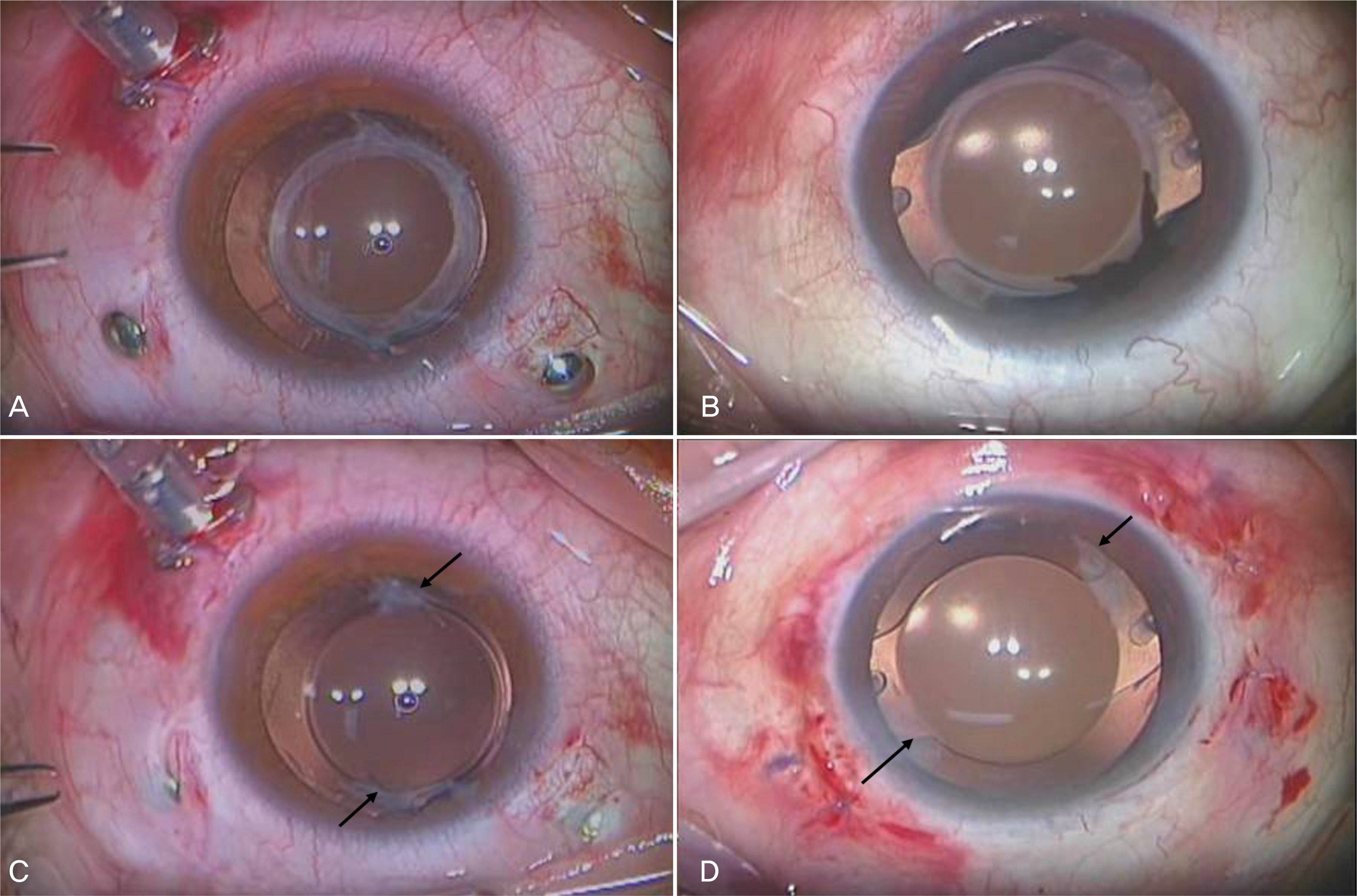J Korean Ophthalmol Soc.
2009 Sep;50(9):1341-1347. 10.3341/jkos.2009.50.9.1341.
Pars Plana Vitrectomy Combined With Surgical Removal of Anterior and Posterior Capsular Opacity
- Affiliations
-
- 1Department of Ophthalmology, Soonchunhyang University College of Medicine, Seoul, Korea. wismile@unitel.co.kr
- KMID: 2212617
- DOI: http://doi.org/10.3341/jkos.2009.50.9.1341
Abstract
- PURPOSE
To evaluate the efficacy and intraocular lens (IOL) stability of vitrectomy combined with the surgical removal of anterior capsular opacity (ACO) and posterior capsular opacity (PCO). METHODS: Forty-four pseudophakic eyes of 43 patients with retinal disorders underwent vitrectomy with surgical removal after cataract diagnosis. Nineteen eyes of 19 patients (group 1) had ACO and PCO removed while 25 eyes of 24 patients (group 2) had only PCO removed. Total removal of the entire lens capsule, except for the area around the haptics, was performed when capsular opacity with fibrosis was observed around the capsulorrhexis margin. LogMAR best corrected visual acuity (BCVA), intraoperative complications and postoperative complications were compared. RESULTS: The retina was flat and postoperative BCVA improved in both groups. Intraoperative complications of IOL dislocation occurred in 3 eyes (15.8%) in group 1 and in 1 eye (4.0%) in group 2 (p=0.178). Among the 4 IOLs, 3 were open-loop haptic IOLs and 1 was a closed-loop haptic IOL. Late postoperative complications of IOL capture occurred in 1 eye (5.3%) in group 1. CONCLUSIONS: Removal of ACO and PCO for better visualization of the peripheral retina resulted in an improved visual recovery while intraoperative complications and postoperative complications were comparable to PCO removal alone. Removal limited to the optic zone would be more stable when considering any adhesion between the lens capsule and the IOL.
Keyword
MeSH Terms
Figure
Reference
-
References
1. Machemer R. The development of pars plana vitrectomy: a personal account. Graefes Arch Clin Exp Ophthalmol. 1995; 233:453–68.2. Campo RV, Sipperley JO. Anterior hyaloidal fibrovascular proliferation after diabetic vitrectomy. Am J Ophthalmol. 1988; 105:432–4.
Article3. Gündüz K, Bakri SJ. Management of proliferative diabetic retinopathy. Compr Ophthalmol Update. 2007; 8:245–56.4. Lewis H, Abrams GW, Williams GA. Anterior hyaloidal fibrovascular proliferation after diabetic vitrectomy. Am J Ophthalmol. 1987; 104:607–13.
Article5. Pollack A, Landa G, Kleinman G, et al. Results of combined surgery by phacoemulsification and vitrectomy. Isr Med Assoc J. 2004; 6:143–6.6. Nawrocki J, Cisiecki S. Combined surgery, phacoemulsification, implantation of intraocular lens and pars plana vitrectomy. Klin Oczna. 2004; 106:596–604.7. Wensheng L, Wu R, Wang X, et al. Clinical complications of combined phacoemulsification and vitrectomy for eyes with coexisting cataract and vitreoretinal diseases. Eur J Ophthalmol. 2009; 19:37–45.
Article8. Ogino N, Kumagai K. Advantage of combined procedure in vitreous surgery. Semin Ophthalmol. 2001; 16:137–8.
Article9. Apple DJ, Solomon KD, Tetz MR, et al. Posterior capsule opacification. Surv Ophthalmol. 1992; 37:73–116.
Article10. Kappelhof JP, Vrensen GF. The pathology of after-cataract. A minireview. Acta Ophthalmol Suppl. 1992; 205:13–24.11. McDonnell PJ, Zarbin MA, Green WR. Posterior capsule opacification in pseudophakic eyes. Ophthalmology. 1983; 90:1548–53.
Article12. Vasavada AR, Raj SM. Anterior capsule relationship of the AcrySof intraocular lens optic and posterior capsule opacification: a prospective randomized clinical trial. Ophthalmology. 2004; 111:886–94.13. McLeod D. Giant retinal tears after central vitrectomy. Br J Ophthalmol. 1985; 69:96–8.
Article14. Kim SH, Chung JW, Chung H, Yu HG. Phacoemulsification and foldable intraocular lens implantation combined with vitrectomy and silicone oil tamponade for severe proliferative diabetic retinopathy. J Cataract Refract Surg. 2004; 30:1721–6.
Article15. Weinreb RN, Wasserstrom JP, Parker W. Neovascular glaucoma following neodymium-YAG laser posterior capsulotomy. Arch Ophthalmol. 1986; 104:730–1.
Article16. Poliner LS, Christianson DJ, Escoffery RF, et al. Neovascular glaucoma after intracapsular and extracapsular cataract extraction in diabetic patients. Am J Ophthalmol. 1985; 100:637–43.
Article17. Park SE, Lee SJ. Mechanized posterior capsulectomy during combined vitrectomy and cataract surgery. J Korean Ophthalmol Soc. 2007; 48:1335–40.
Article18. Lee SJ, Choi KS, Park SH, Jung GY. A Reverse Ab Externo Scleral Fixation for Posterior Chamber Intraocular Lens Dislocation. J Korean Ophthalmol Soc. 2007; 48:1341–5.
Article19. Kim SJ, Lee SJ, Park CH, et al. Long-term stability and visual outcomes of a single-piece, foldable, acrylic intraocular lens for scleral fixation. Retina. 2009; 29:91–7.
Article
- Full Text Links
- Actions
-
Cited
- CITED
-
- Close
- Share
- Similar articles
-
- Pars Plana Vitrectomy Combined with Anterior Capsule-Sparing Lensectomy Clinical Report of 43 Cases
- After-Cataract Following Pars Plana Lensectomy and PCL Implantation
- Posterior Chamber Intraocular Lens Implantation Combined with Pars Plana Lensectomy and Intraocular Foreign Body Removal
- Posterior Chamber Intraocular Lens Implantation in front of the Anterior Lens Capsule during Pars Plana Lensectomy and Vitrectomy
- Iatrogenic Lens Trauma-induced Glaucoma Following Pars Plana Vitrectomy




